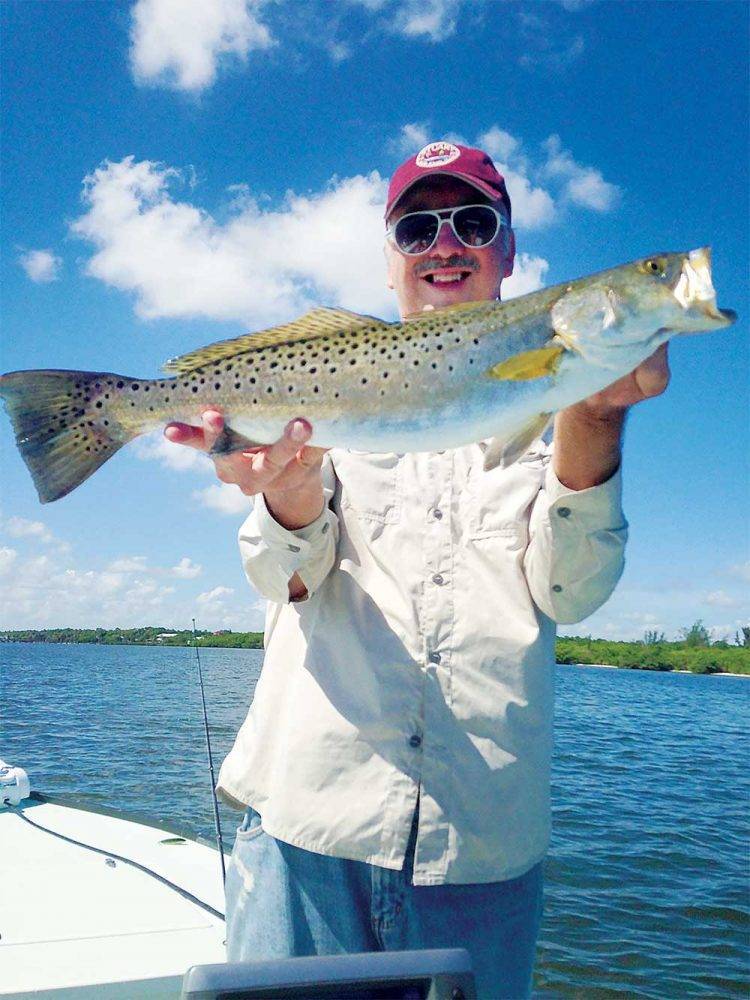 By Richard Matteson
– Stuart Rod and Reel Club:
By Richard Matteson
– Stuart Rod and Reel Club:
You make a long cast. You twitch your topwater plug twice. The water boils. One more twitch and a gator trout explodes on your plug. There’s nothing more exciting than catching topwater trout. The last couple months I’ve been fishing the Indian River Lagoon, mostly with topwater lures. On my best day, I caught a dozen trout with six longer than 23 inches and one just under a whopping 30 inches.
Here are some tips to get started:
The Gear: Fish a 7-foot spinning rod spooled with 6- to 10-pound white braided line. Set the drag medium to light. You want to play the trout without ripping the lure out of its mouth.
The Set Up: Tie in a 2-foot leader of 20- or 30-pound mono or fluorocarbon with a double uni knot. The lure is tied to the leader with a loop knot, which allows better lure movement.
Lures: Poppers like the MirrOlure She-Dog; walking baits like the Zara Spook, the Rapala Skitterwalk or the MirrOlure Floating Paul Brown; prop baits like the Heddon Torpedo, the H2O Xpress Slush Daddy and the Smithwick Devil’s Horse should all spend time on the line, as well as floating soft plastics.
Heavier lures are generally better because they can be cast farther. Some lures have thin treble hooks, which should be changed out.
Technique: Make long casts, give the lure action, allow the lure to stop, try a slower retrieve. Wait until you feel the fish before setting the hook, and don’t set the hook hard. Trout mouths tear easily. For this reason, keep your rod tip low near the water and use a steady retrieve with light drag.
When you fish topwater, trout are going to miss the lure. If the lure is still on the water, they will more than likely hit it again. This is why you shouldn’t set the hook until you feel the fish. I’ve had six strikes in a row from a hungry trout. If a fish misses, let your lure sit for a couple seconds, then give it a twitch and wait. A lot of times this will trigger another strike.
Conditions: Contrary to common wisdom, the best time to fish topwater is all day. There are certain factors that will give you an edge, chief among them is moving tide. My favorite tides are the last half of out-going and the first half of the incoming.
Fish in an area with bait. It’s easy when schools of mullet are splashing the surface. Sometimes pelicans or egrets will tell you there’s bait around when you can’t see it.
Fish in the right areas. Cast over weeds and along weed edges, around and under structure or piers. Sometimes a slight depression in the bottom or a hole in the sand will hold a trout. Fish shallow ridges, sand cuts, drop-offs and any potential ambush point.
Although I’ve caught some small trout on topwater, it’s definitely a big-fish technique. There’s nothing finer than having a monster trout slam your lure and sky in the air.
[easy-social-share]
 By Richard Matteson
– Stuart Rod and Reel Club:
By Richard Matteson
– Stuart Rod and Reel Club: